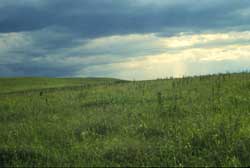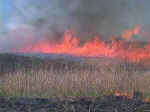
 |
 "As
to the scenery (giving my own thought
and feeling) while I know the standard claim is that Yosemite,
Niagara Falls, the Upper Yellowstone, and the like afford the
greatest natural shows, I am not so sure but the prairies and
plains, while less stunning at first sight, last longer, fill
the esthetic sense fuller, precede all the rest, and make North
America’s characteristic landscape. Even (the prairies’s)
simplest statistics are sublime." "As
to the scenery (giving my own thought
and feeling) while I know the standard claim is that Yosemite,
Niagara Falls, the Upper Yellowstone, and the like afford the
greatest natural shows, I am not so sure but the prairies and
plains, while less stunning at first sight, last longer, fill
the esthetic sense fuller, precede all the rest, and make North
America’s characteristic landscape. Even (the prairies’s)
simplest statistics are sublime."
-Walt Whitman
Specimen Days (1879)
|
 |
Prairies occur in the interior of large continental land masses.
They are characterized by grass and a lack of trees, except
along rivers and streams. They usually occur in flat or gently
rolling topography. Prairies are biological systems balanced by
climate, fire, rainfall and grazing animals. All of these
conditions apply to the tallgrass prairie surrounding Council
Grove.
|
|
Many travelers along the Santa Fe Trail
found the openness of the sun-swept prairie to be alien and
unsettling. Most of them had grown up in the forested, hilled,
and sometimes mountainous East. The journey from Independence or
Westport to Council Grove gave them ten or eleven days of
unmitigated exposure to tallgrass prairie. After a respite in
"The Grove," they would push west where the prairie
landscape would become flatter, the grasses shorter, and the
rains more infrequent.
|
 |
Grasses dominate the tallgrass prairie,
and one species, big bluestem, is the predominant plant. This
tallgrass habitat is home to many living things including more
than four hundred plants, three hundred birds, eighty-five
fishes, eighty mammals, fifty reptiles, fifteen amphibians, and
thousands of insects and invertebrates. Historically bison, elk,
wolves, and grizzly bears roamed this landscape. Although these
species have disappeared, the remaining flora and fauna is
equally unique.
|
|
The fires that have periodically swept
over the prairie are the ally of the grasses and the enemy of
woody plants. Today in early Spring most ranchers near Council
Grove set fire to their pastures to stimulate the growth of
grasses. When the conditions are right in early April, one can
drive out to the hills and watch the fires, long orange festoons
suspended in the blackness of night, march up and down the
hills.
|
 |
In May the burgeoning grass covers the
landscape like a lovely green carpet. In September, when the
grasses begin to go dormant, the prairie turns russet and gold.
Wet years mean taller grass, which sometimes reaches more than
head-high in the valley floors. Often the wind sweeps across the
prairie, rippling the grass into wave-like patterns. This
impression has been noted by many, hence the most often-used
metaphor for the prairie–a sea of grass.
|
 |
The Indians used hundreds of prairie
plants for food, drink, medicine, weapons, smoking, and cordage.
This would have required many centuries of careful observations
and experimentation. Plant knowledge was passed on from
generation to generation through the process we know as culture.
In this way the plants and humans of the prairie became
intimately connected.
|
Related
Link: The
Konza Prairie
|
|


